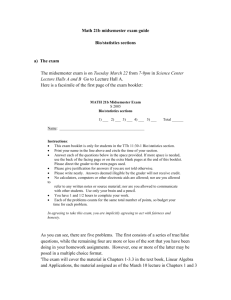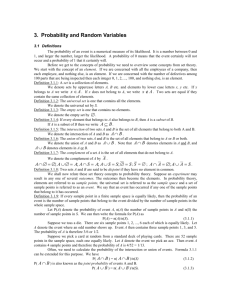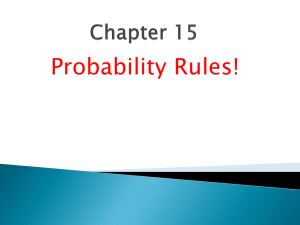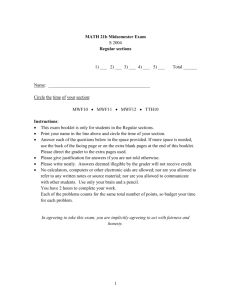Math 21b midsemester exam guide
advertisement
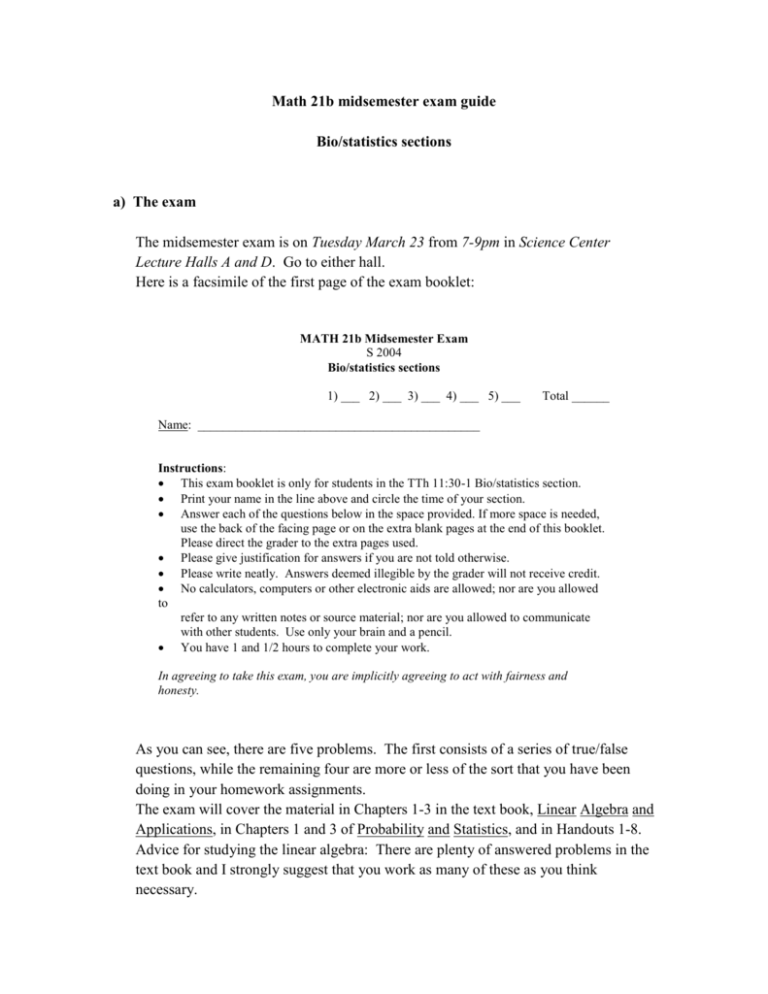
Math 21b midsemester exam guide
Bio/statistics sections
a) The exam
The midsemester exam is on Tuesday March 23 from 7-9pm in Science Center
Lecture Halls A and D. Go to either hall.
Here is a facsimile of the first page of the exam booklet:
MATH 21b Midsemester Exam
S 2004
Bio/statistics sections
1) ___ 2) ___ 3) ___ 4) ___ 5) ___
Total ______
Name: _____________________________________________
Instructions:
This exam booklet is only for students in the TTh 11:30-1 Bio/statistics section.
Print your name in the line above and circle the time of your section.
Answer each of the questions below in the space provided. If more space is needed,
use the back of the facing page or on the extra blank pages at the end of this booklet.
Please direct the grader to the extra pages used.
Please give justification for answers if you are not told otherwise.
Please write neatly. Answers deemed illegible by the grader will not receive credit.
No calculators, computers or other electronic aids are allowed; nor are you allowed
to
refer to any written notes or source material; nor are you allowed to communicate
with other students. Use only your brain and a pencil.
You have 1 and 1/2 hours to complete your work.
In agreeing to take this exam, you are implicitly agreeing to act with fairness and
honesty.
As you can see, there are five problems. The first consists of a series of true/false
questions, while the remaining four are more or less of the sort that you have been
doing in your homework assignments.
The exam will cover the material in Chapters 1-3 in the text book, Linear Algebra and
Applications, in Chapters 1 and 3 of Probability and Statistics, and in Handouts 1-8.
Advice for studying the linear algebra: There are plenty of answered problems in the
text book and I strongly suggest that you work as many of these as you think
necessary.
Advice for studying the probability and statistics: Go over the material in the
handouts and rework the homework problems to understand the concepts. Try to
make up your own examples for the concepts that are mentioned below in Part c of
this study guide. Not that the probability/statistics questions on the exam focus on the
applications of these concepts in simple situations. Part d of this study guide contains
some exercises (with answers) that you can use to test your conceptual understanding.
Old exams: Old exams will not be terribly useful for the two reasons. First, in
previous semesters, there were two midterm exams, not one. Thus, the exams from
previous semesters will either test on material that we have not taught yet, or not test
material that we have. Second, this version of Math 21b is very different from those
taught in previous semesters.
Of the topics covered so far, some I see as more important than others. Given below
is a list of those that are especially important.
b) Linear algebra topics and issues to focus on
Be able to the matrix that corresponds to a linear system of equations.
Be able to rref(A) given the matrix A.
Be able to solve A x = y by computing rref for the augmented matrix, thus rref(A| y ).
Be able to find the inverse of a square matrix A by doing rref(A|I) where I is the
identity matrix.
Be able to use rref(A) to determine whether A is invertible, or if not, what its kernel is
and what its image dimension is.
Become comfortable with the notions that underlie the formal definitions of the
following terms: linear transformation, linear subspace, the span of a set of vectors,
linear dependence and linear independence, invertibility, orthogonality, kernel,
image.
Given a set, { v 1, . . . , v k}, of vectors in Rn, be able to use the rref of the n-row/kcolumn matrix whose j’th column is v j to determine if this set is linearly independent.
Be able to find a basis for the kernel of a linear transformation.
Be able to find a basis for the image of linear transformation.
Know how to multiply matrices and also matrices against vectors. Know how these
concepts respectively relate to the composition of two linear transformations and the
action of a linear transformation.
Know how the kernel and image of the product, AB, of matrices A and B are related
to those of A and B.
Understand how rref(AB) relates to rref(A) and rref(B).
Be able to find the coordinates of a vector with respect to any given basis of Rn.
Be able to find the matrix of a linear transformation of Rn with respect to any given
basis.
c) Probability topics and issues to focus on
Be comfortable with the notions that underlie the terms sample space, event,
probability function, conditional probability, random variable.
Understand the intuition behind the properties in Equation (1.3) of Handout 1.
Understand how to compute conditional probabilities.
Understand the intuition behind Equation (1.5) of Handout 1. Understand how to
interpret this equation as a linear equation. In some sense, this is the most important
equation of all. Thus, you really need to know what it says and the conditions under
which it applies.
Know how to recognize when two events are independent.
Know how to compute the conditional probability of an event A given B in terms of
the the probabilities of A and B and the conditional probability of B given A. (Bayes’
theorem.)
Understand how to compute the probabilities for the values of a random variable.
You should be comfortable with the fact that these probabilities define a probability
function on the space of possible values of the random variable.
Be able to compute the mean and standard deviation of a random variable given the
probabilities of its values.
Understand the definition of the correlation matrix for a pair of random variables, and
understand its relation to the question of whether two random variables are
independent.
Understand the relationship between (4.7) and (4.6) in Handout 4.
Understand the derivation of Equations (5.1) and (5.2) in Handout 5.
Understand the derivation and meaning of Equations (5.5) and (5.6) in Handout 5.
d) Probability review exercises
These exercises are designed to cover many of the key ideas on probability that
have been introduced so far. They will give you a rough idea of the probability issues
that will appear on the mid-semester exam. Some are more involved and some less
involved than the exam problems. The answers are at the end.
1. Suppose a certain quantity can take one of 4 values. Some N versions are observed.
Give a sample space, S, for the suite of values that are possible for the collection of N
measurements.
2. Let S denote the set of {0, 1, …, N}. If k is in this set of integers, define P(k) to be
Z( 12 )k. What must Z be so that P is a probability function?
3. Let S denote the set {1, 2, 3}. Let P denote a probability function on S that assigns
non-zero probability to each element Can the sets {1, 2} and {2, 3} be independent?
4. Let S denote the set of pairs (1, 2) where each k {1, 2, 3, 4}. Suppose that we
set P((1, 2)) = 116 . What is the conditional probability that 1+2 = 5 given that 1 <
3? What is the conditional probability that 1 < 3 given that 1+2 = 5?
5. Suppose that after each unit of time, one of two kinds of molecule is attached to the
end of a growing chain. Label these molecules as and . Suppose that the
probability of attaching at time t is 13 if the last molecule attached is , and the
probability of attaching at time t is 23 if the last molecule attached is . Meanwhile,
the probability of attaching at time t is 13 if the last molecule attached is , and the
probability of attaching at time t is 23 if the last molecule attached is .
a) What is the conditional probability of attaching if the last molecule attached is
?
b) What is the conditional probability of attaching if the last molecule attached is
?
c) Let p(t) denote the probability that the molecule attached at time t is . Is it
correct
to say that p(t) = 23 - 13 p(t-1)?
6. Suppose that 20% of math professors have bad breath, 6% of the Science Center
population has bad breath, and 1% of the Science Center population are math
professors. You walk past someone on your way to class and their breath stuns you.
What is the probability that this person is a math professor?
7. Let S denote the set of pairs (1, 2) where each k {1, 2}. Let T = {1, 2, 4} denote
the possible values of 12. Let Q denote the probability function on T that assigns 12
to {4} and 14 to both {1} and {2} Suppose that Q comes from a probability function,
P, on S by viewing T as the possible values of the random variable that sends (1, 2)
to 12. Write down 3 linear equations with non-zero coefficients that are obeyed by
the four values of P.
8. Let S and T denote the same set as in the previous problem. Let Q also be as in the
previous problem and let P denote some probability function on S that gives Q for the
probabilities of the values of the random variable (1, 2) 12. Compute the mean
and standard deviation as determined by P for this random variable.
9. Let S, T, and P be as in the previous problem. Is the random variable on S that maps
(1, 2) to 1+2 independent from the random variable that assigns 12?
10. Let {1, 2, 3, 4} label four kinds of small molecules that are attached end to end so as
to make a growing chain. Suppose that molecule k is attached at the t’th stage of the
chain with probability 34 if the t-1’st molecule is of type k. If the t-1’st molecule is
any given j ≠ k, then the k’th molecule is attached with probability 121 . Let p (t)
denote the 4-component vector whose k’th entry is the probability that the molecule
of type k appears at the t’th stage of the chain. Find a 44 matrix, A, (not identically
zero) that makes the equation p (t) = A p (t-1) hold.
Answers
1. Once the 4-values are labeled by the integers from 1 through 4, the sample space
consists of the 4N possible N-tuples of the form (1, …, N) where each k can be
either 1, 2, 3, or 4.
2. The constraint is that the sum of the probabilities must equal 1, so Z =
2N
2 N1 1
.
3. Never. Let A = {1, 2} and B = {2, 3}. Then P(A B) = P(2) and thus, if A and B
are independent, then this must equal P(A)P(B). This is [P(1) + P(2)][P(2) + P(3)] =
[1 – P(3)] [1 – P(1)] = 1 – P(1) – P(3) + P(1) P(3) = P(2) + P(1) P(3). This equals
P(2) only if P(1) is zero or P(3) is zero.
4. The set, B, where 1 < 3 has eight elements so has probability 12 . The set, A, where
the sum is 5 has 4 elements so has probability 14 . The intersection, A B, this the set
where 1 < 3 and 1+2 = 5, consists of two elements and has probability 18 . Then,
the conditional probability P(A|B) = 18 / 12 = 14 . The conditional probability P(B|A) is
the ratio 18 / 14 = 12 .
5. a) You are told that this is 13 .
b) You are told that this is 23 .
c) Use the formula p(t) = Prob( at t| at t-1) p(t-1) + Prob( at t| at t-1) p( at t-1).
Since p( at t-1) = (1 – p(t)), this says that p(t) = 13 p(t-1) + 23 (1-p(t)) = 23 - 13 p(t-1).
This is an exercise using Bayes’ theorem. Let A = event the person is a math
professor, and B = event the person has bad breath. You are asked to find P(A|B) and
you are given P(A) = 0.01, P(B) = 0.06 and P(B|A) = 0.2. Since P(A|B) =
P(B|A)·P(A)/P(B), this gives P(A|B) = 0.0333···.
Q(1) =
Q(2) =
Q(4) =
1
4
1
4
1
2
= P(1,1).
= P(1,2) + P(2,1).
= P(2,2).
The mean is 1· 14 + 2· 14 + 4· 12 = 141 . The standard deviation is the square root of the
1
9 1
25 1
27
3
following sum: 49
16 · 4 + 1 6 · 4 + 16 · 2 = 16 . Thus, = 4 √3.
The random variables are not independent since you can determine the value of one
knowing that of the other. Listing the values of 1+2 as {2, 3, 4} and those of 12
as {1, 2, 4}, the corresponding 33 correlation matix is
163 161
3
161
16
1
8 18
18
18
1
4
Let pk(t) denote the k’th entry of p (t). According to the scenario given,
34
1
12
A= 1
12
1
12
.
1
12
3
4
1
12
1
12
1
12
3
4
1
12
1
12
1
12
3
4
1
12
1
12
Note that in this example, pk(t) = 34 pk(t-1) +
1
4
(1-pk(t-1)) =
1
4
+ 12 pk(t-1).
